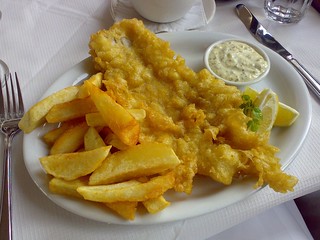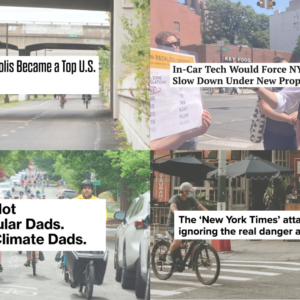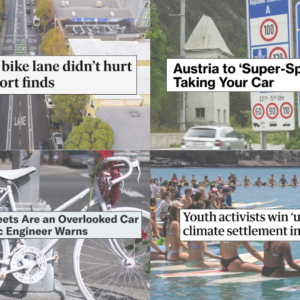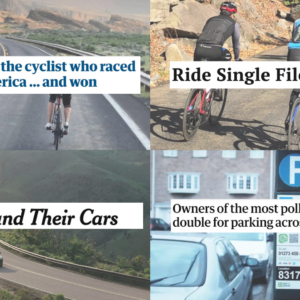
(Photo: Edinburgh Blog)
Here are the biking-related links from around the world that caught our eyes this week:
Beer-battered driving: A Wisconsin man pulled over by a sheriff’s deputy said he hadn’t been drinking, only eating beer-battered fish. It would be his 10th drunken-driving conviction.
Minneapolis victory: The Minneapolis Bicycle Coalition says the city’s new budget, with $750,000 for protected bike lanes (3-6 miles’ worth) and eight open streets events, is its “best ever.”
Ask not what…: The most effective bike advocates “don’t position themselves as a special-interest group fighting for a few feet here or a few feet there on the street, but act as part of a larger effort to make streets more livable.” That’s one of five bits of wisdom from the country’s leading bike tourist.
Regulatory slowdown: Two bike share launches in New Jersey have been delayed six months by a Federal Communications Commission review of German electronic components.
Dangerous helmet: UVEX Sports has recalled a bike helmet because its chinstrap was failing and threatening wearers with injury.
Tired truckers: Last week’s federal spending bill included a rule change that could let truck drivers spend up to an average 82 hours a week on the road, up from the current 70.
Stoplight detection: A North Carolina company is testing a smartphone app that could tell a stoplight that you’re on a bike, waiting for it to change.
Gas tax: The big gas price drop is a window of opportunity for gas tax hikes, some say.
Snow removal: Arlington County outside D.C. is setting aside $300,000 to plow bikeways.
Advertisement
Amazon’s quicksilver: Amazon delivery drones aren’t here yet, but for now they’re hiring bike messengers.
Protected walking: Chicago advocates are pushing to separate walking and biking on their signature Lakefront Trail.
Popular bridge: The aging Forest Grove bridge that might be closed to auto traffic carries 1,100 motor vehicles a day.
Speed camera retreat: An estimated $30 million in annual revenue didn’t prevent the repeal of a new school-zone speed camera campaign on Long Island after a “deafening chorus of opposition.”
Gender gap: “Young women around age 11 or 12 or 13 start to go underground, really shrink into themselves,” explains one New York advocate for female biking. It’s one of many reasons to fight the biking gender gap.
Women on wheels: Hard to blame the reporter behind this 1896 story for being enthusiastic:
My costumes are ALWAYS tasteful and my skill striking. MT Brooklyn's female cyclists, 1896. pic.twitter.com/esGD4w9dtR via @yaybikes
— Jessica Roberts (@jessicaroberts) December 15, 2014
Night riding: “The number of times I see fancy, expensive utility bikes with cheap, inadequate headlights clipped to the handlebars like an afterthought never ceases to amaze me,” writes Lovely Bicycle in a post of tips for making friends with the dark.
Suburban bikelash: “The day is approaching in Marin when a cycling-comes-first approach becomes politically toxic,” writes Marin County newspaper columnist Dick Spotswood, predicting that the ill behavior of a few people on bikes is driving local action against biking improvements.
And in your video of the week, NYC’s transit agency has released a candidate for least realistic public safety announcement of the year:
If you come across a noteworthy bicycle story, send it in via email, Tweet @bikeportland, or whatever else and we’ll consider adding it to next Monday’s roundup.







Thanks for reading.
BikePortland has served this community with independent community journalism since 2005. We rely on subscriptions from readers like you to survive. Your financial support is vital in keeping this valuable resource alive and well.
Please subscribe today to strengthen and expand our work.
Ah, yes, most bike/bus accidents involve people riding into the back of a bus while taking selfies. wtf.
I’d love to see the Car version of that vido
At least taking a selfie might lead to riding into something–this was even more absurd. The selfie was a few scenes back. He rode into the bus right after the on-screen message Loud Music Not Good; he stood and hammered, apparently all hopped-up on bass, and sprinted into the bus with both hands on the bars.
To me, headphone warnings are much like insisting on high-vis clothing and helmets–it’s more about blaming the victim than addressing the problem. No one rides into something because they can’t hear–only because they’re not looking. I’m usually not wearing earbuds, but I still wouldn’t leave the bike lane without looking back–there could be any number of quiet things coming, from faster riders to electric cars. I rely so little on hearing in traffic that I can easily, and safely, do without it. You can’t hear what’s behind you while you’re in a car, either, but no one seems to consider that a problem.
I must politely disagree. The fact that car drivers are generally insulated from ambient external sounds by virtue of the car’s cabin, etc., doesn’t justify cyclists intentionally eliminating (or greatly reducing) auditory input that could significantly degrade their ability to evade or anticipate hazards. Sounds matter too.
…so are you suggesting people in cars should drive with the windows open, & not listen to music?
Just being the devil’s advocate here.
No.
What I am suggesting is that bike riders shouldn’t adopt dangerous practices simply because car drivers do.
http://www.nizkor.org/features/fallacies/two-wrongs-make-a-right.html
Not because drivers do, rather, because it’s not dangerous. I agree that drivers indulge all types of dangerous behavior, and that cars have all kinds of dangerous design flaws. These things are categorized and studied by people like NHTSA. They understand what causes crahses, so they issue warnings about distracted driving, and they have PSAs for things like using your headlights in daytime for added safety or just wearing a seatbelt–but I’ve never seen a study implicating reduced auditory input or a campaign calling for drivers to roll down the windows for safety.
Besides, on the rare occasion when I do use headphones, they’re puny earbuds, and I’m generally tuned to NPR to catch a show I don’t want to miss. I’m not talking noise-cancelling ear cans thumping bass here–I can still hear better than I’d be able to in a car.
I hope you’re careful with those earbuds, though. I recently read an article about hearing health relative to earbud use and how people often underestimate the sound’s effect because the sound isn’t contained like with noise-canceling headphones. If only I could remember the URL, this comment might actually be effective. Haha.
Honestly, I think that plugging one’s ears and listening to music or newscasts while riding reduces attentiveness. How can it not? If the goal is to remain focused, staying alert to traffic and anticipating potential hazards, listening to All Things Considered cannot possibly help with that. Studies show that humans are not good at multitasking, and that’s true of cognitive multitasking, not just motor-skills multi-tasking. Here in Hawaii wearing headphones while driving a car is illegal; I’m willing to bet that the same is true in other states as well. I know that seems strange since playing one’s radio full blast with the windows up is not illegal for drivers, but nobody said traffic laws are consistent. If they were, we’d mandate that all automobile occupants wear helmets. After all, head injuries are the number one killer in car crashes.
Me, I’ll just listen to NPR at home or save the podcast.
Now that’s a different argument; in this case you’re talking about being distracted, not just not being able to hear. This has been studied, by researchers looking into the effects of different potential sources of distraction for drivers. Mainly they were trying to quantify what level of distraction people experience with different devices. While interactive technology like cell phones or Siri scored dangerously high, listening to the radio was rated as a negligible if not non-existent hazard.
Still, I agree, this is more of a potential problem–it doesn’t matter what you can see or hear if you’re not paying attention.
Comparing drivers and bikers’ ability to hear things going on around them is pointless IMO, since almost everything about a car is dangerous and anti-social (speed, size, and the reduction in visibility and sound). It’s still socially acceptable to drive dangerously, and I’m afraid it will be for the remainder of my lifetime. We’re still at 30,000+ motor vehicle-related deaths per year. Sickening.
To get back on topic, headphones on cyclists, as long as they are legal, are a personal preference and have no statistical impact on “road fatalities.” Our local DOTs have a responsibility to inform the uninformed that they *can* reduce cyclist awareness, however.
What hazard will I evade by hearing cars? I hear them coming constantly; I know they’re back there. However, I can’t tell from sound which one might hit me. I’ve never turned around to look at what’s coming because something sounded suspicious. They all sound like they might hit me–I just have to accept it on faith that they won’t. That is how traffic works, after all, you maintain a straight and true course, and approaching vehicles are responsible for not hitting you. When I want to deviate from that course, I’d never do so without looking back first–whatever I might hear back there is insignificant; I won’t make a move in traffic without visual confirmation.
Existence is unpredictable. I opt for not wearing headphones so I might optimize easy identification and navigation of events I don’t expect rather than those I experience frequently. Call me prudent if you like. 🙂
Another thought is that wearing headphones might prevent me from becoming aware of struggles other people are experiencing somewhere outside my vision or visual focus.
You have to wonder why deaf people haven’t been banned from biking yet… 😉
Can we do a PSA about the “cars that go ‘boom'” as well then? :\
Beer Batter’s 10th DUI? WTF?! What will it take before they lock him away for good? Blood on the streets?
This – and situations like this: http://www.cyclelicio.us/2014/whats-going-on-in-district-7/ – are what I’d really like to see people taking to the streets to protest with Ferguson fervor.
That’s Wisconsin for you, K’Tesh. My homeland is a drunk driver’s paradise. You can rack up dozens of convictions there and still drive. It’s sad.
A couple weeks ago I met a woman injured in an auto collision for which another woman was issued a 9th DUI: http://www.argusleader.com/story/news/crime/2014/07/16/woman-faces-th-dui-crash-injured-motorcycle/12721075/
Some human beings are so quick to trust their abilities and those of others :(.
gas price/gas tax
This is our problem; why we are in this pickle to begin with.
We are predisposed to making policy in this lurching, opportunistic, smoke-and-mirrors fashion. Maybe the voters won’t notice or mind so much if we sneak in a gas tax hike right now when prices are low?
Are we really incapable of having a dispassionate discussion about the future, climate, oil, infrastructure, fiscal solvency without resorting to cheap tricks like this?
</rhetorical>
But have we actually tried?
To have that discussion? It’s ongoing, no? Global talks in Peru, how to pay for roads in Portland, budget at the national level. What’s obvious to you (and evident to me) doesn’t always float to the top. Why? Politics, greed, education, philosophy…
Think I’ll go for a ride.
December of last year was the last time it showed up in congress, TMK. They’re essentially done for the year at this point, and January brings the power shift (theoretically a swing to the right). May is when the FHWA Trust Fund deficit is due to be extended.
http://www.washingtonpost.com/posteverything/wp/2014/12/16/theres-some-bipartisan-support-for-an-excellent-and-timely-idea-raise-the-federal-gas-tax-and-replenish-the-highway-trust-fund/
And even though this cheap trick indeed offers an important opportunity to address a specific ballooning deficit, it will continue to be labeled as “tax and spend by the liberals” by the same politicians who just eased bank regulations and campaign funding ceilings.
Yes, we really are incapable of such a discussion.
Interesting dichotomy between the article by LAB’s Steve Clark on effective bike advocacy versus a very different approach taken in Marin, which has been effective enough to provoke articles like this one that basically say “behave, stay out of the way, and start paying your fair share.” We definitely need a two-pronged approach, with organizations like LAB focused on broader cultural and systemic changes, while local diplomacy by active individuals focus on addressing infrastructure shortcomings and educating city councils, traffic engineers, and law enforcement. That Marin is building a roundabout on a MUP to slow cyclists speaks volumes to the inherent flaw in placing “speeding” cyclists among pedestrians in order to keep them off the streets where they might get hit, or worse yet impede auto traffic. Yes, separated ‘bikeways’ are safe when designed properly, but in the US we build MUPs and point to them as reasons that bikes don’t need to be mixed with cars. We call them “bike paths” to label them as a mandatory alternative to biking on roadways.
I believe as cyclists we need to fight for both approaches, and most importantly keep teaching planners and engineers that bicycling with traffic is safe and we don’t need to be protected mid-block by walls that prevent motorists from seeing us (I call these “makeshift MUPS” and can’t point to several here that steal valuable shoulder width and spit riders out around blind corners at intersections – very different from a reasonably well-planned MUP like Fanno Creek up in your neck of the woods).
Marin is also an interesting case study…what with the lack of local jobs (long distance commutes) combined with heavy investment by the Feds into bike infrastructure ($20m 2005 Nonmotorized Transportation Pilot Program)…could make for some successful changes that might catch a lot of long time residents by surprise when their rural/sub-urban roadways get a multimodal urban upgrade (2008 to 2012).
http://usa.streetsblog.org/2014/06/26/fhwa-bike-ped-investments-pay-off-by-cutting-traffic-and-improving-health/
http://www.marinij.com/dickspotswood/ci_27076897/dick-spotswood-marin-bike-lobbys-political-clout-is
Cycling and cycling activism is a powerful wedge issue for the republican/conservative demographic. And given changing attitudes about gay people and latino-americans there is a desperate need for more of these types of wedge issues.
Thanks for the link…
Cyclist and pedestrians paying a toll to cross the Golden Gate? Really? What is the negative impact on bridge maintenance and upkeep of these two groups? Hardly anything compared to the cars and trucks and buses.
The salt air does quite a number on the bridge. It’s not all autos causing the upkeep costs. There is a daily management cost of changing the number of lanes in each direction on the bridge between morning and evening commutes.
The reality is that the GG Transit Authority is collecting more than the cost of the maintenance of the bridge, but it is also subsidizing the cost of the bus and ferry transit systems. (source: http://www.sfgate.com/bayarea/article/Higher-tolls-OKd-for-Golden-Gate-Bridge-5278985.php)
So while the cost of bikes and peds is nil from a maintenance standpoint, I guess they’re just trying monetize a user fee from anyone using the bridge in any way – both from commuters and from tourists (tourists would still come, even for a fee) so that they can make up their budget deficits.
This source says more than half the collected tolls subsidize the other transpo systems: http://ww2.kqed.org/news/2014/02/11/a-tale-of-two-toll-hikes-all-at-once-or-bit-by-bit/
Sorry to keep piling on, but from that second link are these very interesting stats:
– There is NO tax support for the bridge.
– More than 25% of the commute traffic moving into SF is on mass transit supported by the subsidies (that’s a good thing!).
– There had been a pedestrian toll (10¢) all the way up to 1971
Not sure what’s crazier. Claiming that the batter on his fried fish was the source of the alcohol smell, or the fact that he was driving around after ***NINE*** DUIs
Amazon ‘quicksilver’ story links to a truncated Wall Street Journal click bait to subscribe…be nice if the powers that be would allow us lowly server types some intuit of what lies ahead…without having to subscribe that is.
Wait, that’s odd — the link is to a Marketwatch excerpt of the original WSJ piece. I/we don’t subscribe to either, but I don’t hit a paywall. One trick that usually works for WSJ pieces is to google the headline and click from there; their paywall seems to exempt search traffic. Try that link.
Thanks, Michael! Paywall. Another of those non sequiturs I’m too old to remember.
Besides the Uvex helmet, that site mentions that Salsa Bearpaw forks and Felt Cyclocross frames (2015) have been recalled this month (among other non-bike stuff): http://www.cpsc.gov/en/Recalls/
Bike product recalls: http://www.bicycleretailer.com/recalls-0
The news regarding Minneapolis’ investment in bike infrastructure is even better than it sounds. Streets.mn has had a few pieces lately on St. Paul’s future investment and Hennepin County’s getting on board with bike lanes (finally). Due to the political layout of the the MSP area, getting St. Paul, Metro Council and Hennepin on board is required to make biking really work. All in all, the MSP area looks to be pushing forward at a good pace.
Oh, and just because this will make Portland MTBers green with envy, it was announced at the Winter Bike Expo that we are getting another 17 miles of singletrack at Lake Rebecca in 2015. That means starting in 2016 there will be over 100 miles of singletrack available within 20 miles of downtown MSP.